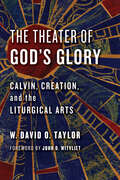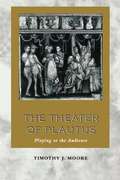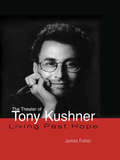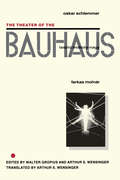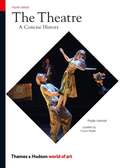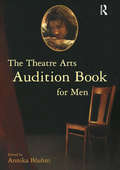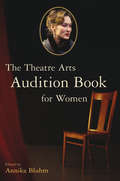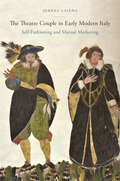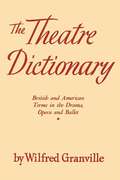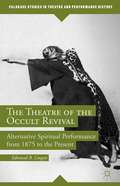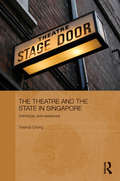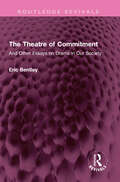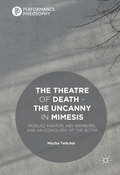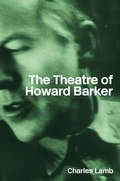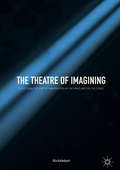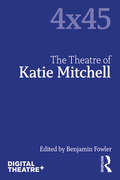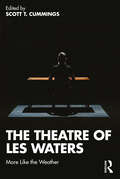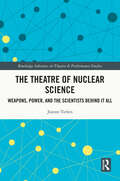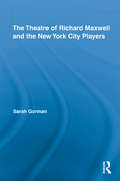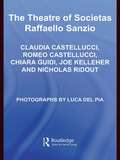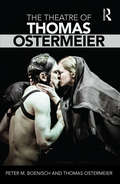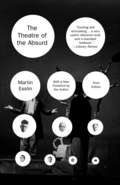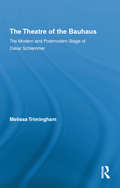- Table View
- List View
The Theater of God's Glory: Calvin, Creation, and the Liturgical Arts
by W. David TaylorA theological framework for the liturgical arts rooted in John Calvin Both detractors and supporters of John Calvin have deemed him an enemy of the physical body, a pessimist toward creation, and a negative influence on the liturgical arts. But, says W. David O. Taylor, that only tells half of the story. Taylor examines Calvin's trinitarian theology as it intersects his doctrine of the physical creation in order to argue for a positive theological account of the liturgical arts. He does so believing that Calvin's theology can serve, perhaps surprisingly, as a rich resource for understanding the theological purposes of the arts in corporate worship. Drawing on Calvin's Institutes, biblical commentaries, sermons, catechisms, treatises, and worship orders, this book represents one of the most thorough investigations available of John Calvin's theology of the physical creation—and the promising possibilities it opens up for the formative role of the arts in worship.
The Theater of God's Glory: Calvin, Creation, and the Liturgical Arts (The Calvin Institute of Christian Worship Liturgical Studies (CICW))
by W. David TaylorA theological framework for the liturgical arts rooted in John Calvin Both detractors and supporters of John Calvin have deemed him an enemy of the physical body, a pessimist toward creation, and a negative influence on the liturgical arts. But, says W. David O. Taylor, that only tells half of the story. Taylor examines Calvin's trinitarian theology as it intersects his doctrine of the physical creation in order to argue for a positive theological account of the liturgical arts. He does so believing that Calvin's theology can serve, perhaps surprisingly, as a rich resource for understanding the theological purposes of the arts in corporate worship. Drawing on Calvin's Institutes, biblical commentaries, sermons, catechisms, treatises, and worship orders, this book represents one of the most thorough investigations available of John Calvin's theology of the physical creation—and the promising possibilities it opens up for the formative role of the arts in worship.
The Theater of Plautus: Playing to the Audience
by Timothy J. MooreThe relationship between actors and spectators has been of perennial interest to playwrights. The Roman playwright Plautus (ca. 200 BCE) was particularly adept at manipulating this relationship. Plautus allowed his actors to acknowledge freely the illusion in which they were taking part, to elicit laughter through humorous asides and monologues, and simultaneously to flatter and tease the spectators.<P><P>These metatheatrical techniques are the focus of Timothy J. Moore's innovative study of the comedies of Plautus. The first part of the book examines Plautus' techniques in detail, while the second part explores how he used them in the plays Pseudolus, Amphitruo, Curculio, Truculentus, Casina, and Captivi. Moore shows that Plautus employed these dramatic devices not only to entertain his audience but also to satirize aspects of Roman society, such as shady business practices and extravagant spending on prostitutes, and to challenge his spectators' preconceptions about such issues as marriage and slavery. These findings forge new links between Roman comedy and the social and historical context of its performance.
The Theater of Tony Kushner (Studies in Modern Drama)
by James FisherThe Theater of Tony Kushner is a comprehensive portrait of the life and work of one of America's most important contemporary playwrights.
The Theater of the Bauhaus
by Oskar Schlemmer Arthur S. Wensinger Walter Gropius Lazlo Moholy-Nagy Farkas MolnarFew creative movements have been more influential than the Bauhaus, under the leadership of Walter Gropius. The art of the theater commanded special attention. The text in this volume is a loose collection of essays by Oskar Schlemmer, Laszlo Moholy-Nagy, and Farkas Molnár (who in an illustrated essay shares his vision of a total theatre space), with an introduction by Bauhaus leader Walter Gropius. Originally published in German in 1924, Die Bühne im Bauhaus was translated by A. S. Wensinger and published by Wesleyan in 1961. It was prepared with the full cooperation of Walter Gropius and his introduction was written specially for this edition.From Bauhaus experiments there emerged a new aesthetic of stage design and presentation, a new concept of "total theater." Its principles and practices, revolutionary in their time and far in advance of all but the most experimental stagecraft today, were largely the work of Oskar Schlemmer, Laszlo Moholy-Nagy, and their students. Profusely illustrated and startling in its typography (the work of Moholy-Nagy), the 1924 volume quickly became a collector's item and is now virtually unobtainable. Those interested in the stage, the modern visual arts, or in the bold steps of the men of genius who broadened the horizons of aesthetic experience will appreciate that this translation is available again.
The Theatre A Concise History 4th edition
by Enoch Brater Phyllis HartnollActing, direction, stagecraft, theatre architecture and design, the extraordinary evolution of dramatic literature—here is an all-embracing and richly illustrated history, worldwide in scope and ranging from the ancient origins of the theatre in the choral hymns sung around the altar of Dionysus to the endless variety of forms that theatre takes in our own day. For this fourth edition, Enoch Brater, Professor of English and Theatre at the University of Michigan, has contributed a revised and extended final chapter on contemporary theatre and updated factual information throughout the book
The Theatre Arts Audition Book for Men
by Annika BluhmFirst Published in 2003. Routledge is an imprint of Taylor & Francis, an informa company.
The Theatre Arts Audition Book for Women
by Annika BluhmFirst Published in 2003. Routledge is an imprint of Taylor & Francis, an informa company.
The Theatre Couple in Early Modern Italy: Self-Fashioning and Mutual Marketing (Performing Celebrity)
by Serena LaienaWho were the first celebrity couples? How was their success forged? Which forces influenced their self-fashioning and marketing strategies? These questions are at the core of this study, which looks at the birth of a phenomenon, that of the couple in show business, with a focus on the promotional strategies devised by two professional performers: Giovan Battista Andreini (1576–1654) and Virginia Ramponi (1583–ca.1631). This book examines their artistic path – a deliberately crafted and mutually beneficial joint career – and links it to the historical, social, and cultural context of post-Tridentine Italy. Rooted in a broad research field, encompassing theatre history, Italian studies, celebrity studies, gender studies, and performance studies, The Theatre Couple in Early Modern Italy revises the conventional view of the Italian diva, investigates the deployment of Catholic devotion as a marketing tool, and argues for the importance of the couple system in the history of Commedia dell’Arte, a system that continues to shape celebrity today.
The Theatre Dictionary: British and American Terms in Drama, Opera, and Ballet
by Wilfred GranvilleWilfred Granville’s Theatre Dictionary is an essential guide to the terms in British and American Drama, Opera, and Ballet, and this volume is of incomparable value for the student and practical theatre worker on either side of the Atlantic. It offers a fascinating compilation of technical jargon and colloquial slang pertaining to the business of the theatre, from the legitimate stage to vaudeville and road shows. For several years Wilfred Granville was actively engaged in the theatre as actor, stage director, and producer and speaks from firsthand knowledge of his subject. A specialist in glossaries, Wilfred Granville has treated theatre speech in a readable, unacademic way though there is no inadequacy in his treatment of etymologies of words and phrases recorded. Wilfred Granville was a British lexicographer known for his jargon and slang dictionaries and his military histories. He researched and wrote dictionaries on sea and naval slang and theatre terms as well as naval military histories.
The Theatre Of The Occult Revival
by Edmund B. LinganBased on field research and archival study, this book offers an in-depth exploration of the religious foundations, political and social significance, and aesthetic aspects of the theatre created by several of the most influential leaders of the Occult Revival: Katherine Tingley, Rudolf Steiner, Marie Steiner-von Sivers, Aleister Crowley, Alexander Mathews, and Gerald Gardner. The Occult Revival was an international surge of interest in the supernatural, magic, and Eastern mysticism that thrived in Europe and the United States between the late nineteenth-century and the mid-twentieth-century. By studying the theatre that was developed in affiliation with occult movements, this book shows how theatre contributed to the complication and fragmentation of Western religious culture during the turn-of-the-century Occult Revival and how theatre continues to play a part in the development of occult rituals and beliefs.
The Theatre and the State in Singapore: Orthodoxy and Resistance (Routledge Contemporary Southeast Asia Series)
by Terence ChongThis book provides a comprehensive examination of the contemporary English-language theatre field in Singapore. It describes Singapore theatre as a politically dynamic field that is often a site for struggle and resistance against state orthodoxy, and how the cultural policies of the ruling People’s Action Party (PAP) have shaped Singapore theatre. The book traces such cultural policies and their impact from the early 1960s, and shows how the PAP used theatre – and arts and culture more widely – as a key part of its nation building programme. Terence Chong argues that this diverse theatre community not only comes into regular conflict with the state, but often collaborates with it - depending on the rewards at stake, not to mention the assortment of intra-communal conflicts as different practitioners and groups vie for the same resources. It goes on to explore how new forms of theatre, especially English-language avant garde theatre, represented resistance to such government cultural control; how the government often exerts its power ‘behind-the-scenes’ to preserve its moral legitimacy; and conversely how middle class theatre practitioners’ resistance to state power is strongly influenced by class and cultural capital. Based on extensive original research including interviews with theatre directors and other theatre professionals, the book provides a wealth of information on theatre in Singapore overall, and not just on theatre-state relations.
The Theatre of Commitment: And Other Essays on Drama in Our Society (Routledge Revivals)
by Eric BentleyFirst published in 1967 The Theatre of Commitment presents miscellaneous collection of seven essays written over fifteen years. Eric Bentley deals with themes like is the drama an extinct species; the American drama; what is theatre; the pro and con of political theatre; letter to a would-be playwright and the theatre of commitment. For most people, theatre of commitment is political theater, though Bentley indicates that the word commitment is broad enough to embrace the work of any serious writer even if the commitment is to non-commitment. This is an interesting read for students of theatre and performance studies.
The Theatre of Death – The Uncanny in Mimesis
by Mischa TwitchinThis book is concerned with such questions asthe following: What is the life of the past in the present? How might "thetheatre of death" and "the uncanny in mimesis" allow us to conceive of theafterlife of a supposedly ephemeral art practice? How might a theatricaliconology engage with such fundamental social relations as those between theliving and the dead? Distinct from the dominant expectation that actors shouldappear life-like onstage, why is it that some theatre artists - from Craig toCastellucci - have conceived of the actor in the image of the dead? This bookexplores such questions through the implications of the twofold analogyproposed in its very title: as theatre is to the uncanny, so death is tomimesis; and as theatre is to mimesis, so death is to the uncanny. Walter Benjamin once observed that: "The point at issuein the theatre today can be more accurately defined in relation to the stagethan to the play. It concerns the filling-in of the orchestra pit. The abysswhich separates the actors from the audience like the dead from the living. . . " Ifthe relation between the living and the dead can be thought of in terms of ananalogy with ancient theatre, what about modernity?
The Theatre of Howard Barker
by Charles LambIn this second, fully revised edition of his acclaimed study of Barker's work, Charles Lamb sets out to make emotional sense of the characters and their interactions. This is a detailed exploration of the 'scene of seduction' - the challenge, the secret, the abject and the catastrophic, processes which dominate Barker's work. For Lamb, the power of Barker's plays is to be found in the exposure to the irrational and its promotion of a state of unknowing. This revised edition includes: * a new interview with Barker;* a revised introduction, * an updated bibliography * a full production chronology. For students of Barker and for actors and directors working with this unique material, Lamb's book is a vital and illuminating text.
The Theatre of Imagining: A Cultural History of Imagination in the Mind and on the Stage
by Ulla KallenbachThis book is the first comprehensive analysis of the fascinating and strikingly diverse history of imagination in the context of theatre and drama. Key questions that the book explores are: How do spectators engage with the drama in performance, and how does the historical context influence the dramaturgy of imagination? In addition to offering a study of the cultural history and theory of imagination in a European context including its philosophical, physiological, cultural and political implications, the book examines the cultural enactment of imagination in the drama text and offers practical strategies for analyzing the aesthetic practice of imagination in drama texts. It covers the early modern to the late modernist period and includes three in-depth case studies: William Shakespeare’s Macbeth (c.1606); Henrik Ibsen’s A Doll’s House (1879); and Eugène Ionesco’s The Killer (1957).
The Theatre of Katie Mitchell (4x45)
by Benjamin FowlerThis first volume in the 4x45 series investigates the work of theatre director Katie Mitchell. Pausing to reconsider a career in progress, it engages with some of Mitchell’s most recent work in the UK and Europe across theatre, opera, and Live Cinema. It also takes a longer view, considering the early turns that Mitchell took at the start of her career in the late 1980s. This volume gives full scope to the voice of the practitioner, alongside scholarly perspectives, in order to understand the work from within. Interviews with Mitchell’s collaborators get inside her process – and inside the thinking of key artists who help craft the distinctive visual, aesthetic and technological forms of Mitchell’s productions. Three major concerns criss-cross these contributions: the political implications of aesthetic form; the meaning of Mitchell’s interest in the radical project of early Naturalism; and the influence of Europe on Mitchell’s avant-garde experimentalism, which often draws on technology to open up new modes of perception and experience. An accessible and encompassing examination of one of Europe's most celebrated theatrical talents, 4x45 | The Theatre of Katie Mitchell is a unique resource for scholars,students and practitioners of Theatre Studies, Performance and Directing.
The Theatre of Les Waters: More Like the Weather
by Scott T. CummingsThe Theatre of Les Waters: More Like the Weather combines original writings from Les Waters with short essays by a wide range of his collaborators, creating a personal and multi-faceted portrait of an influential director, revered mentor, and inspirational theatre artist. The book begins with a critical introduction of Waters’s work, followed by essays written by a wide range of Waters's collaborators over the past four decades. These essays are framed by shorter pieces of writing by Waters himself: reflections, inspirations, observations, and personal anecdotes. At the heart of this book lies the notion that the director’s central position in theatrical production is defined by collaboration and that a study of directing should take into account how a director works with playwrights, designers, actors, stage managers, and dramaturgs to turn artistic vision into concrete reality on stage. An insightful resource for early career or student directors in theatre programs, The Theatre of Les Waters sheds light on the art of theatre directing by exploring the work of a major theatre artist whose accomplished career sits at the heart of American theatre in the 21st century. Drawing on aspects of memoir, case study, interview, miscellany, biography, and criticism, this is also an enlightening read for anyone with an interest in how theatre artists bring their creative vision to life.
The Theatre of Luis Valdez (4x45)
by Michael M. ChemersThe Theatre of Luis Valdez focuses on the life and work of American playwright and director Luis Valdez, probably best known for his landmark 1979 play Zoot Suit – the first play by a Latinx playwright to appear on Broadway – and founder of El Teatro Campesino, the oldest surviving community theatre in the United States. Built around first-hand discussions of Valdez’s work, this collection gives an in-depth understanding of where ‘the godfather of Chicano theatre’ fits in the grand scheme of American drama and performance. Collaborators Edward James Olmos and Alma Martinez talk about working with Valdez and El Teatro Campesino; scholar Leticia Garcia interviews Jorge Huerta, the leading authority on Chicanx and Latinx theatre on the impact of Valdez work; and Luis Valdez himself contributes a lecture on all aspects of his craft from political resistance and the migrant experience to actor training and dramatic form. A concise and accessible study, 4x45 || Luis Valdez is the go-to resource for scholars, students and theatre practitioners looking for an introduction to this seminal figure in modern American performance.
The Theatre of Nuclear Science: Weapons, Power, and the Scientists Behind it All (Routledge Advances in Theatre & Performance Studies)
by Jeanne P TiehenThe Theatre of Nuclear Science theoretically explores theatrical representations of nuclear science to reconsider a science that can have consequences beyond imagination. Focusing on a series of nuclear science plays that span the twentieth and twenty-first centuries, and including performances of nuclear science in museums, film, and media, Jeanne Tiehen argues why theatre and its unique qualities can offer important perspectives on this imperative topic. This book will be of great interest to students and scholars of theatre, politics, and literature.
The Theatre of Richard Maxwell and the New York City Players (Routledge Advances in Theatre & Performance Studies)
by Sarah GormanThe theatre of Richard Maxwell and the New York City Players has received significant international recognition over the past ten years. The company has received three OBIEs, for House (1999), Drummer Wanted (2002) and Good Samaritans (2005). Maxwell received a Guggenheim Fellowship in 2010 and has been commissioned by venues in the United States, the United Kingdom, Germany, Austria, the Netherlands, France, Belgium and Ireland. Although his productions generate a plethora of reviews, there is a deficit of material providing a critical and sustained engagement with his work. The aim of this book is to provide a critical survey of Maxwell’s work since 1992, including his early participation in Cook County Theater Department. Touching upon the acting, production and rehearsal processes of NYC Player’s work, and Maxwell's representations of space, community, race, and gender, this volume provides scholars with an important overview of a key figure in contemporary drama.
The Theatre of Societas Raffaello Sanzio
by Nicholas Ridout Joe Kelleher Claudia Castellucci Chiara Guidi Romeo CastellucciThe Theatre of Socìetas Raffaello Sanzio chronicles four years in the life of an extraordinary Italian theatre company whose work is widely recognized as some of the most exciting theatre currently being made in Europe. In the first English-language book to document their work, company founders, Claudia Castellucci, Romeo Castellucci and Chiara Guidi, discuss their approach to theatre making with Joe Kelleher and Nicholas Ridout. At the centre of the book is a detailed exploration of the company's eleven episode cycle of tragic theatre, Tragedia Endogonida (2002–2004,) including: production notes and extensive correspondence giving insights into the creative process essays by and conversations with company members alongside critical responses by their two co-authors seventy-two photographs of the company's work. This is a significant collection of theoretical and practical reflections on the subject of theatre in the twenty-first century, and an indispensible written and visual document of the company's work.
The Theatre of Thomas Ostermeier
by Peter M Boenisch Thomas OstermeierThomas Ostermeier is the most internationally recognised German theatre director of the present. With this book, he presents his directorial method for the first time. The Theatre of Thomas Ostermeier provides a toolkit for understanding and enacting the strategies of his advanced contemporary approach to staging dramatic texts. In addition, the book includes: Ostermeier’s seminal essays, lectures and manifestos translated into English for the first time. Over 140 photos from the archive of Arno Declair, who has documented Ostermeier’s work at the Schaubühne Berlin for many years, and by others. In-depth ‘casebook’ studies of two of his productions: Ibsen’s An Enemy of the People (2012) and Shakespeare’s Richard III (2015) Contributions from Ostermeier’s actors and his closest collaborators to show how his principles are put into practice. An extraordinary, richly illustrated insight into Ostermeier’s working methods, this volume will be of interest to practitioners and scholars of contemporary European theatre alike.
The Theatre of the Absurd
by Martin EsslinIn 1953, Samuel Beckett’sWaiting for Godotpremiered at a tiny avant-garde theatre in Paris; within five years, it had been translated into more than twenty languages and seen by more than a million spectators. Its startling popularity marked the emergence of a new type of theatre whose proponents—Beckett, Ionesco, Genet, Pinter, and others—shattered dramatic conventions and paid scant attention to psychological realism, while highlighting their characters’ inability to understand one another. In 1961, Martin Esslin gave a name to the phenomenon in his groundbreaking study of these playwrights who dramatized the absurdity at the core of the human condition. Over four decades after its initial publication, Esslin’s landmark book has lost none of its freshness. The questions these dramatists raise about the struggle for meaning in a purposeless world are still as incisive and necessary today as they were when Beckett’s tramps first waited beneath a dying tree on a lonely country road for a mysterious benefactor who would never show. Authoritative, engaging, and eminently readable,The Theatre of the Absurdis nothing short of a classic: vital reading for anyone with an interest in the theatre.
The Theatre of the Bauhaus: The Modern and Postmodern Stage of Oskar Schlemmer (Routledge Advances in Theatre & Performance Studies #16)
by Melissa TriminghamFocusing on the work of painter, choreographer and scenic designer Oskar Schlemmer, the "Master Magician" and leader of the Theatre Workshop, this book explains this "theatre of high modernism" and its historical role in design and performance studies; further, it connects the Bauhaus exploration of space with contemporary stages and contemporary ethics, aesthetics and society. The idea of "theatre of space" is used to highlight twentieth-century practitioners who privilege the visual, aural, and plastic qualities of the stage above character, narrative and, themes (for example Schlemmer himself, Robert Wilson, Tadeusz Kantor, Robert Lepage). This impressive volume will be of use to students and academics involved in the areas of twentieth-century performance, the history of performance art, the history of avant-garde theatre, modern German theatre, and Weimar-era performance.
